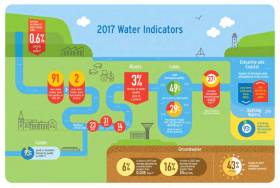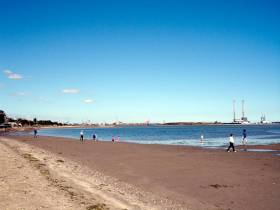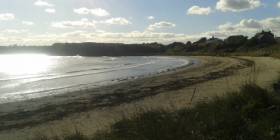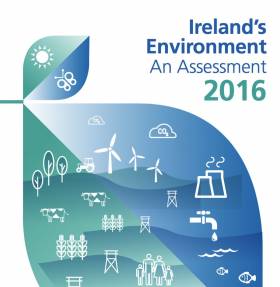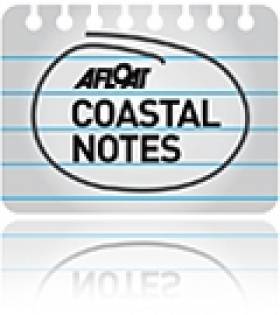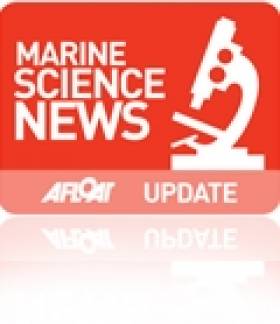Displaying items by tag: water quality
As open water sea swimmers prepare for a Galway Bay crossing this weekend, Irish Water has said there is “no proven link” between a recent serious pollution incident in the city and the quality of bathing water off Galway’s beaches writes Lorna Siggins
However, swimmers have called for more regular and longer-term bathing water quality testing, and more transparency in relation to water quality issues.
Six weeks ago, Galway City Council prohibited swimming off beaches at Silver Strand and Salthill and issued a warning about Grattan road beach in Lower Salthill, after elevated levels of bacteria were detected.
The prohibitions were lifted in time for the June bank holiday weekend, and the city council initially ruled out several possibilities, including Mutton Island sewage treatment plant, visiting cruise ships and slurry spreading run-off.
It subsequently stated that the elevated levels of bacteria were due to a fault with the test.
A month later, on July 5th, Galway harbourmaster Capt Brian Sheridan stated in response to media queries that “the current sewage issue is not as a result of port operational activities, including cruise ships that anchor in the bay”.
Galway Bay is a popular destination for cruise ships, which are covered by the international MARPOL regulations. Vessels from another flag state can only discharge treated sewage at least three nautical miles from the nearest land or untreated sewage at least 12 nautical miles from the nearest land.
Capt Sheridan stressed that he issued Galway Port Company’s own prohibition notices, stating that ships must be at least 12 nautical miles west of the Aran islands.
Capt Sam Field Corbett, who owns the old dock known as the “Mud docks” in the inner Galway harbour, said he believed the source of contamination could be linked to a sewage overflow, which he first reported to Galway City Council in March, and to the Environmental Protection Agency (EPA) in early May when there was no action.
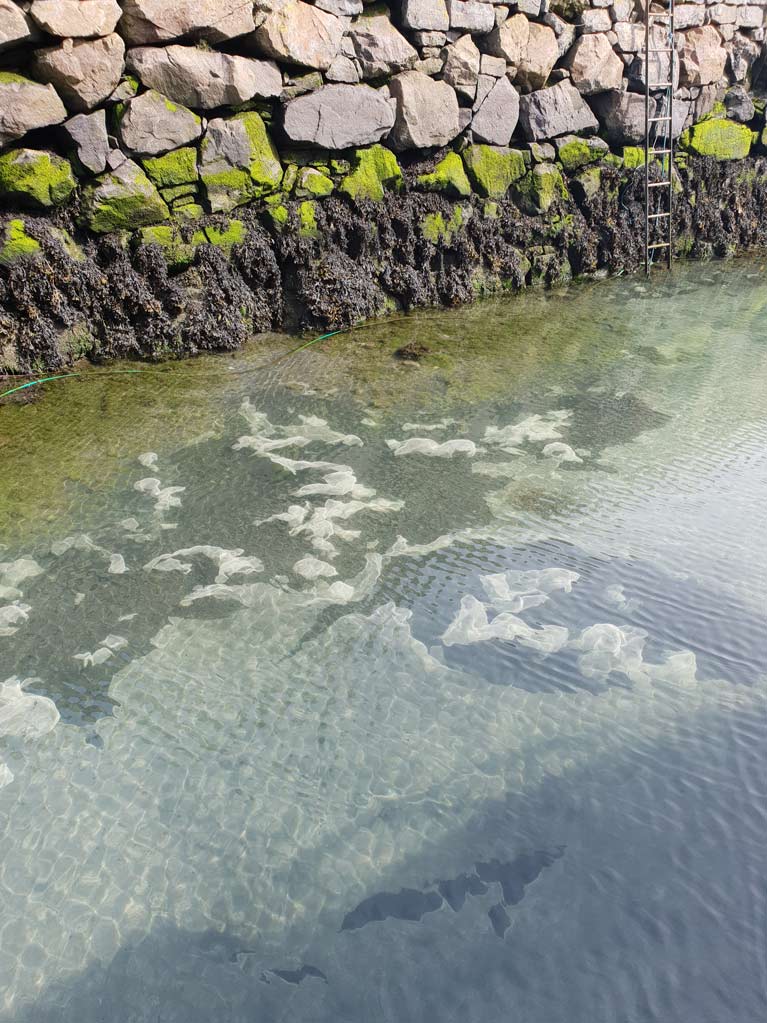 Capt Sam Field Corbett sent this photo to the EPA in May. Corbett says it depicts evidence of sewage and waste at low tide in the Galway city mud dock
Capt Sam Field Corbett sent this photo to the EPA in May. Corbett says it depicts evidence of sewage and waste at low tide in the Galway city mud dock
On May 15th, he informed the EPA that it appeared the sewage had stopped flowing, but evidence of human waste was still present in what he described as “once a thriving eco-system”
On June 14th, Irish Water announced that it was upgrading one of Galway’s Victorian sewer systems, which would address “odour and blockage issues” , as part of a 2 million euro project with Galway County Council due for completion in October.
Irish Water has confirmed that a sewer blockage had caused an overflow at the Mud Docks, and this was “cleared”, and a pipe in Eyre Square repaired.
It said that RPS consultants were separately conducting survey works across the entire Galway city network.
“There is no proven link to the issue at the Mud docks and any issues arising at the bathing waters in Galway city in late May,”Irish Water said, noting that all data reported to date during the 2019 bathing water season in Galway city had been classified as “excellent” or “good”.
Galway sea swimmer Brian Coll, who is undertaking the Frances Thornton Memorial Galway Bay Swim in aid of Cancer Care West this weekend with his family, said he believes there needs to be more frequent water quality testing from April to October.
"The current situation where bathing water quality is tested every two weeks is insufficient, given that Salthill has one of the most active sea swimming communities in Ireland," he said.
"There needs to be weekly water testing and also more active environmental monitoring for visiting cruise ships. This is standard in other cruise ship destinations such as Alaska and Norway, where there are regular checks for any discharges of sewage and wastewater from the ships,” he said.
“We need to have confidence in the quality of our bathing water,” Mr Coll noted.
Sampling of bathing water only needs to take place once a month between May and September under the 2006 EU Bathing Water Directive, but the EPA says some local authorities test more frequently.
The directive is going to be reviewed, and frequency of testing may form part of this, but the review is at its early stages.
Galway City Council's Environment Department said that bathing water quality testing is carried out in accordance with a schedule agreed in advance with the EPA.
"For Blue Flag beaches this is every fortnight and for other beaches this is every week. Once the sample is taken it takes 48 hours for the test to react and as soon as these results are received they are published. Therefore they are published within 48 hours of the test but the test is carried out every two weeks for Salthill and Silverstrand. This is exactly the same frequency any other Blue Flag beach in the country," it said.
Galway City Council says it tests every second week. Results of bathing water quality testing on frequently used beaches around the coastline are posted on the EPA’s website, beaches.ie
Historic Low In Fish Kills Welcomed - But Water Quality Concerns Remain
Inland Fisheries Ireland (IFI) has noted with caution the findings from the Environmental Protection Agency’s (EPA) report on water quality in 2017.
While it welcomes the fact that the number of fish kills in Irish waters were at a historic low last year, IFI is calling for continued awareness of water quality issues in light of the EPA’s conclusion that water quality is once again in decline.
According to this latest report, there was 14 fish kills in 2017, affecting 7.8km of river with 2,123 dead fish recovered. This is significantly lower than the worst years of 1987 and 1989 when there were more than 100 fish kills reported.
IFI’s Environmental Officers carried out 26,000 environmental inspections last year across agricultural sites, habitats, industrial sites, wastewater and water treatment plants, civil engineering sites and forestry sites.
Despite the positive drop in serious pollution events causing fish mortalities, IFI remains concerned about the reduction of water quality, with the EPA reporting a 3% drop in river water quality since 2016 and a 0.6% loss in high-quality river sites.
The inland fisheries and sea angling resource contributes €836 million to the Irish economy every year and supports 11,000 jobs in rural communities.
“Ireland has some of the best wild fisheries in Europe and while water quality in Ireland still compares favourably with our European neighbours. The current decline is a source of concern as any impact on the quality of our waters can have a negative impact on the freshwater fisheries resource,” said IFI chief executive Dr Ciaran Byrne.
“Not only is the quality of our natural environment and aquatic habitat inextricably linked to the appeal of Ireland as an angling and holiday destination, it is also a very important source of wellbeing for our people.
“It is essential that we protect and conserve our freshwater assets, meaning our rivers and lakes. The long-term conservation of the resource requires maintenance of healthy and ecologically viable ecosystems.
“That means that we need to prioritise monitoring and protecting water quality as well as dealing with other issues such as removing fish migration barriers, improving practices which cause physical changes to fisheries habitat, dealing with changes in water quantity and controlling the spread of invasive species,” Dr Byrne added.
Toxic ‘Algae’ Threatens Wildlife In Killarney Lake
#Toxic - Pet owners have been advised to be vigilant over an outbreak of toxic blue-green ‘algae’ in a Killarney lake, as The Irish Times reports.
Lough Leane has been signposted by Kerry County Council over the presence of Cyanobacteria that has turned the waters a soupy pea-green colour.
A number of dogs died after exposure to the bacteria during a previous bloom on the lake shore in 2016.
Suspected similar cases have also been reported at Lough Mask as well as waterways further east, including Ballymore Eustace on the River Liffey.
Meanwhile, scientists at the Galway-Mayo Institute of Technology are preparing to use drones to test the water quality of lakes on the West Coast.
GMIT’s Marine and Freshwater Research Centre has secured €132,000 in funding from the EPA for the scheme that will allow for real-time feedback of camera images and data.
Licensed drone pilots will work with lake biologists and water scientists on the two-year project, part of Ireland’s mandate under the EU’s Water Framework Directive.
The Irish Times has more on this story HERE.
#CoastalNotes - Seven beaches in Dublin and Galway have failed to meet the EU’s minimum standards for bathing water quality.
That’s according to the latest Bathing Water Quality in Ireland report from the Environmental Protection Agency (EPA), which identifies Sandymount and Merrion Strands, Loughshinny, Portrane and Rush South in Co Dublin, as well as Ballyloughane in Galway city and Clifden in the west of the county, as problem areas.
Three of the Dublin beaches are repeat offenders, with Merrion and Loughshinny marked as ‘poor’ in the previous two reports, while Portrane was listed among 2016’s worst bathing spots.
Galway fares a little better in 2017’s report, with Trá na bhForbacha upgraded to ‘vulnerable’ — though it, along with Clifden and Ballyloughane, remains at the mercy of pollution from runoff, septic discharges and the like.
Pollution events were also up in 2017, with 163 incident notices issues by local authorities — almost double the total recorded the previous year. Twelve of these notices resulted in bathing restrictions at Merrion and Sandymount Strands alone.
On a more positive note, 93% or 132 of the 142 bathing areas surveyed for the 2017 report meet the EU minimum for swimming water quality.
Nationally, bathing water standards are on par with last year’s report, which found almost three-quarters of Irish swimming spots met the EU’s strict bar for ‘excellent’ water quality.
The full EPA report is available to read or download HERE.
#CoastalNotes - Three beaches in Dublin and three in Galway have failed to meet the minimum standards for bathing water quality, according to the Environmental Protection Agency (EPA).
The Irish Times covers the latest EPA Report on Bathing Water Quality, which listed repeat offenders Ballyloughane in Co Galway and Dublin’s Merrion Strand and Loughshinny, along with Portrane in North Co Dublin and Galway’s Clifden and Trá na bhForbacha as beaches especially vulnerable to pollution.
Youghal’s front strand, Duncannon in Wexford and the south beach at Rush in Co Dublin, which were listed as ‘poor’ in last year’s report, showed enough improvement in their bathing water quality to be classified as ‘sufficient’.
Overall, almost three-quarters of Ireland’s bathing spots — both coastal and inland — were classified as having ‘excellent’ water quality.
The Irish Times has more on the story, while the full EPA report on Ireland’s bathing water quality can be found HERE.
Decline In High-Quality River Sites Is Wake-Up Call Says IFI Chief
#Angling - Continued vigilance on Ireland’s rivers and lakes is required, says Ireland’s inland fisheries body, as a new report indicates a substantial loss in the number of highest quality river sites.
According to the latest State of the Environment Report from the Environmental Protection Agency (EPA), only 21 sites were classified as the highest quality rivers (0.7% of sites) in most recent monitoring period (2013-2015). This compares with 575 sites between 1987-1990 and 82 sites between 2001-2003.
In addition, 18% of monitored rivers and 27% of monitored lakes were defined as ‘less than good status’ due to fish ecological status as monitored reported on by Inland Fisheries Ireland (IFI).
Preliminary assessment suggests that barriers to fish migration and physical deterioration of habitats may be partly to blame.
Between 2010 and 2012, there were also 70 fish kills reported. However serious pollution of rivers has fallen to just over 6km compared to 17km in 2010-2012 and 53km in 2007-2009.
“We need to protect our fish populations and conserve our resource for the next generation,” said IFI chief executive Dr Ciaran Byrne on the new report, adding that Ireland’s fisheries resource “is worth €836 million annually to the Irish economy and supports over 11,000 jobs often in rural and peripheral communities.
“We have over 273,000 domestic anglers currently in Ireland and in 2015, 163,000 international visitors fished here. Angling and the fisheries resource, if developed in a conservation focused manner, offers huge recreational and economic potential for Ireland now and into the future.
“We have some of the best wild fisheries in Europe and water quality in Ireland still compares favourably with our European neighbours. However, the dramatic reduction in the number of our pristine rivers is a wake-up call which we need to address.”
#BathingQuality - Six Irish coastal beaches – half of them in the Greater Dublin Area – fall short of the Environmental Protection Agency's (EPA) minimum required standard for water quality.
Rush's south beach and Loughshinny in north Co Dublin joined Merrion Strand in south Dublin, Youghal's front strand in Co Cork, Duncannon in Wexford and Ballyloughane in Co Galway in the list of bathing areas classed as being of 'Poor' quality in the EPA's Bathing Water Quality in Ireland report for 2015.
The EPA explains that the 'Poor' class, which averages data collected between 2012 and 2015, reflects bathing areas that "may be subject to more frequent, or more significant, pollution events" often impacted by "nearby sewage discharges, most commonly as a result of heavy rainfall".
All six beaches on the current 'Poor' list showed improvement in the last year, recording a number of 'Excellent' scores in 2015, but pollution concerns remain.
And in the case of Merrion Strand, bird droppings from seagulls congregating in the area are a serious issue, as they carry as much as 10 times the bacteria of human waste.
Overall, bathing quality in Irish waters remains "very high", according to the report, with just over 93% of sites meeting the minimum EU standards.
Three-quarters of these – 101 of the 137 areas monitored - were classed as being 'Excellent', with the counties of Clare, Kerry, Leitrim and Louth standing apart with unblemished records for their bathing quality.
The complete EPA bathing water quality report is available to read or download HERE.
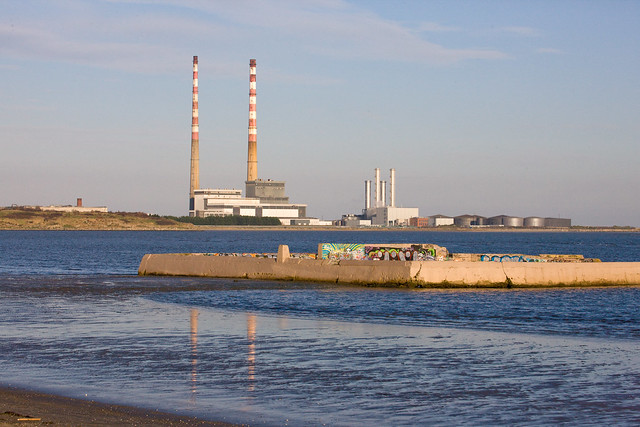
'Poisonous Parsnips' Warning For NI Beaches
#CoastalNotes - 'Poisonous parsnips' on Co Antrim coastal beaches have prompted warnings to dog owners, as BelfastLive reports.
Warning signs were put up at Ballygally, Carnfunnock and Drains Bay earlier this month after locals found evidence of hemlock water dropwort roots, which are extremely toxic to animals – particularly at this time of year.
It's thought that the plant is previously responsible for the death of at least one dog that tried to eat one at Drains Bay in 2014.
In other recent news from Northern Ireland, a seal spotted swimming in the River Lagan has been hailed as a sign of its good water quality.
Video of what appears to be a grey seal happily bobbing along upstream near the Ormeau Embankment was captued by Belfast man Brendan McNeice, who thought the sight "unusual".
But marine wildlife expert Tanya Singleton told UTV News that seals swimming so far up the river is actually a regular occurrence – and a good sign for the waterway's health as they chase booming fish stocks as far as Lisburn.
94% Of Irish Beaches Meet Stricter Bathing Quality Standards
#CoastalNotes - Ireland gets an 'A' for seaside bathing, as 94% of beaches have met the EU's new stricter water quality standards.
And as RTÉ News reports, three out of every four Irish beaches have been rated as 'excellent' on the new scale for levels of microbiological contaminants, which is "twice as strict" as in previous years.
But seven out of 136 bathing places monitored by the Environmental Protection Agency (EPA) in 2014 still failed the test.
Youghal in Cork, Clifden and Ballyloughane in Galway, Rush's south beach in North Co Dublin, Duncannon in Wexford, Ardmore in Waterford and Liliput on Lough Ennell in the Midlands were all rated 'poor', for the most part due to wastewater discharges.
Ten other popular seaside spots – including Trá na mBan in Spiddal and the beaches at Merrion Strand, Loughshinny and Balbriggan's front strand in Co Dublin - were rated as 'sufficient' as they are still prone to periodic pollution episodes, according to The Irish Times.
But there was good news for the denizens of Trá Inis Oirr in Galway Bay, which scored an 'excellent' rating in its first year on the EPA's list.
The Aran Islands beach was added in the same year that nearby Trá gCaorach became a first-time winner in the National Green Coast Awards.
The EPA's Splash website maps out the latest bathing quality ratings for beaches around and throughout Ireland. The agency's report on bathing quality in 2014 can be found HERE.
Irish Coastal Water Quality 'Generally Good' Says Final Report On Biological Effects & Chemical Measurements
#MarineScience - The final report for Biological Effects and Chemical Measurements in Irish Marine Waters has just been published after four years of collaborative research led by Trinity College Dublin in partnership with the Marine Institute, Shannon Aquatic Toxicity Laboratory (Enterprise Ireland) and Dublin Institute of Technology.
The marine environment is affected by a complex mixture of man-made and naturally-occurring substances derived from a variety of sources such as shipping, sewage or industrial discharges or through accidental or historic spills of hazardous substances.
“Current monitoring and assessment of the pollution status of the marine environment in Ireland is mainly reliant on chemical measurements of contaminants in sediments, water and in 'bio-indicator' species," said Prof Jim Wilson of TCD.
"The success of this pilot project is that it reports the first major Irish study that examined both pollutant levels in the coastal environment while concurrently assessing the potential for biological-based effects on organisms exposed to these often hazardous substances."
Drawing on diverse expertise provided by a number of Government and academic research institutions, the study completed testing of a variety of chemical and biological-based monitoring tools in diverse coastal locations in Dublin, Wexford, Cork, Kerry, Clare and Galway.
The project confirmed that Irish coastal water quality is generally good, with the most elevated pollutant levels detected typically at more populated locations subject to greater impacts and pressures.
Lower pollutant levels were generally evident in less populated areas where diffuse pollution rather than local sources are of greater relevance.
In isolation, chemical measurement studies do not always explain the potential of the pressures that affect the ecosystem as a whole. The findings of this report note that using a suite of biological effects as part of an integrated approach to support chemical measurements gives a better overview of the health of our marine ecosystem.
For example, chemical compounds and mixtures present in the environment in combination with natural changes in the ocean, such as salinity or temperature, can all work in synergy or against each other to elicit diverse effects on the marine environment and on resident marine species.
“Individual pollutants or a mix of chemicals can cause metabolic disorders, increases in diseases becoming more common, as well as having an adverse effect on population growth and on species reproduction potential," said Dr Michelle Giltrap of TCD.
"An example of this is the reproductive effects on dog whelks, which were affected by the legacy of exposure to the biocide Tributyltin (TBT). TBT was widely used as an effective antifoulant on the hulls of ships and boats to prevent growth of aquatic organisms. Although use of TBT has been phased out internationally, the effects are still evident, but have been diminishing over time."
Dr Brian Donlon, who manages the Environmental Protection Agency's Research Programme, said “ongoing international commitments under the Marine Strategy Framework Directive require that member states monitor pollution in their marine waters by assessing both the level of chemical contamination and the effects of this contamination on organisms.
"Continued research and monitoring is required in order to further develop the dedicated chemical measurement and ecotoxicological response datasets.”
Dr Brendan McHugh of the Marine Institute added: “Integrated biological effects and chemical monitoring, including use of the novel tools, offer the potential for a more ecologically oriented approach to pollution monitoring and for further enhancing and supporting management actions in maintaining a sustainable marine environment."
The full report is available HERE on the Marine Institute’s Open Access Repository. The research project and was carried out under the Sea Change Strategy and the Marine Sub-Programme of the National Development Plan 2007-2013, and was jointly funded by the EPA and the Marine Institute.




























